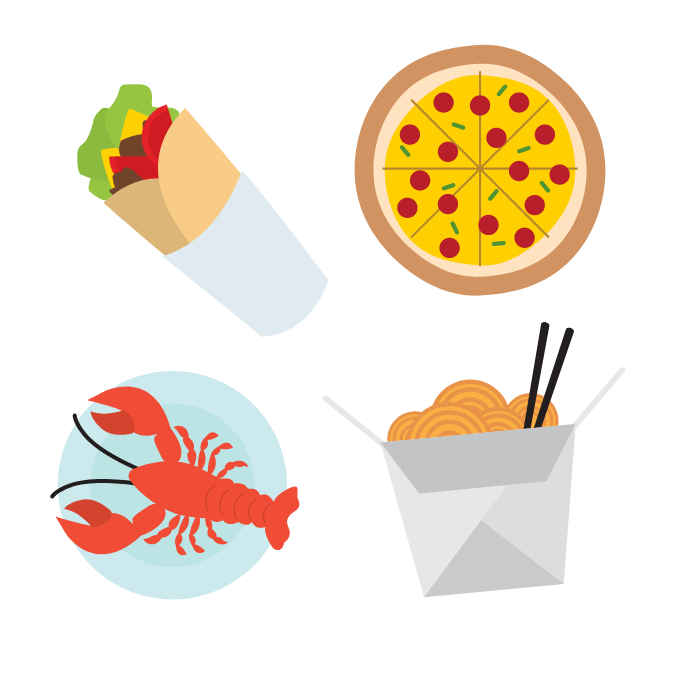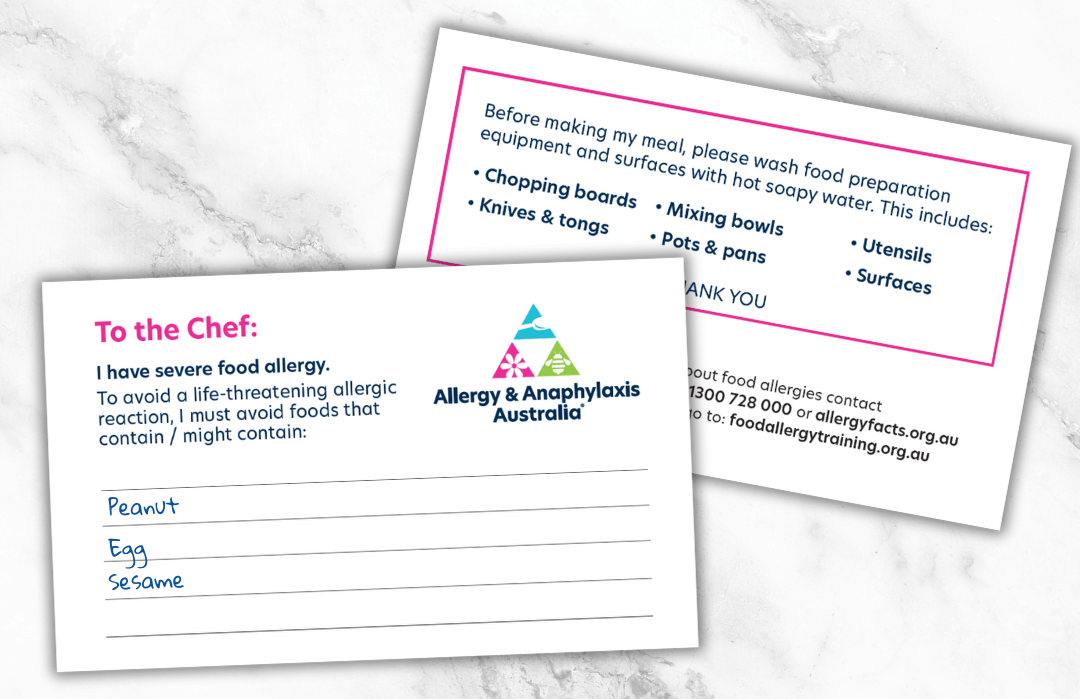Updated September 2024
On this page
When eating out, there are many things you can do to help reduce the risk of an allergic reaction. Plan ahead and tell food service staff and people you are eating with about your allergy.

Finding a restaurant or food outlet
- Speak to the manager or chef before you arrive, if possible.
- Try to go to a restaurant at a less busy time.
- Check the menu on the restaurant website and in person when you arrive.
- Tell the staff/chef about your food allergy and ask if they can make you a meal that does not contain the food you are allergic to.

Avoiding high risk places and dishes
- If you are allergic to fish or crustacea (shellfish), avoid seafood restaurants. Keep cross contamination in mind at other restaurants.
- If you are allergic to peanut or tree nuts, avoid Asian and Indian style dishes and restaurants.
- If you are allergic to sesame, avoid most Middle Eastern style dishes, desserts/cakes and salads including dressings and toppings such as za’atar and dukkah.
- Avoid buffet style restaurants where serving utensils can be shared and foods may be mixed.
- Be aware that fried foods may share cooking oil with crustacea, fish, egg and other allergens.
- If you are allergic to egg or milk, avoid crumbed or battered foods and creamy sauces that contain these ingredients.
- Some pasta dishes, meatballs and hamburgers may contain egg or peanut/tree nuts, and often contain wheat.
- Vegetarian style food often contains peanut/tree nut ingredients, including vegetarian cheese, which may be made from tree nuts such as cashews.
- Remember pastries and desserts often contain common allergens.

Ordering food and drinks
- Always tell staff about the food you are allergic to before ordering, even if a QR code ordering system is in use. If the staff are unsure, ask them to speak with the chef.
- Menus do not need to list food allergens, so always speak to staff about your food allergy.
- Use an A&AA Chef Card to list your food allergen/s. Ask that the card go to the chef and be returned with your meal, so it’s more likely the right meal is given to you.
- Be prepared to wait while staff check ingredients of the food you have ordered, and while they speak with the staff preparing your food.
- Restaurants cannot give a guarantee that cross-contamination has not occurred — the risk can be reduced with careful meal preparation and label reading by the chef, but it can never be removed completely.
- Choose dishes with fewer ingredients as there is less chance of a mistake.
- Check salad toppings and dressings.
- You may be served first or last — be patient.
- Stay in the same seat once you have ordered your food. This helps to make sure that you are given the meal you ordered.

Making careful food choices
- Consider ordering simply prepared dishes with a few simple ingredients such as grilled meats with steamed vegetables, and a baked potato. Consider avoiding sauces as they may contain allergens.
- Consider fresh fruit for dessert, if not allergic to fruit.
- You need to tell staff about your allergy when ordering every time, even if you have previously eaten the same meal at the same restaurant.
- Do not assume a dish in one restaurant is the same in another.
- Do not share food or taste someone else’s food.
- Do not share straws, cups, cutlery or any other food utensils.

Being prepared
- Always carry your ASCIA Action Plan and adrenaline (epinephrine) device with you (if prescribed).
- If you do not have your adrenaline device (such as Anapen®, EpiPen®) with you, DO NOT EAT.
- If at any time during your meal you think you may be having an allergic reaction, STOP EATING. Tell those around you and use your ASCIA Action Plan to help manage the allergic reaction. See signs and symptoms on the ASCIA plan and follow instructions carefully.

Beware:
Examples of ‘hidden’ ingredients
- Pesto may contain tree nuts or peanuts
- Satay sauce contains peanuts
- Worcestershire sauce often contains anchovies
- Tahini is made from sesame seeds
- Hummus contains chickpeas and tahini (made from sesame seeds)
- Sweet pastry bases may contain ground peanuts or tree nuts
- Marzipan contains ground almonds and may contain egg
- Praline contains tree nuts and nougat contains tree nuts and eggs
- Breads, cakes and pastries that are shiny may have been glazed with milk or egg
- Breads and ice cream may contain egg
- Salami and other processed meats may contain milk
- Beer usually contains wheat
Eating out brochure
There are many ways you can help reduce the risk of an allergic reaction. Download our Eating out with food allergies to help you better navigate the process.
Chef Cards (English and translated)

Communication tools, such as our Chef Cards, are useful when telling staff about your allergy in restaurants, cafes, clubs and function centres such as wedding venues etc.
Simply download the card, write or print your food allergies on the card, print it out and give it to food service staff when eating out.
The wait staff should give your personalised card to the chef and the card should be returned with your meal to help make sure the right meal is given to the right person.
Click here to read more about our chef cards.
Report a reaction flowchart
Learn how to report an incident if you experience an allergic reaction while eating out.
More about eating out with food allergy
Waivers and Indemnity Forms
When eating out, you may be asked to sign a waiver or indemnity form when you tell people about your food allergy.
FAQs
-
A customer can refuse to sign a waiver/indemnity form. It would then be up to the business whether it decides to serve the customer and accept the risk of an allergic reaction happening. Equally, the customer may decide they are not comfortable eating at that business and eat elsewhere.
-
A cafe, restaurant or function centre can refuse to provide safe food/drink for you and refuse service. Although the restaurant should try to prepare and serve you food without your allergen(s), it will not be required to do so if this will result in unjustifiable hardship for the venue (that is, it will be extremely difficult). Factors that may be considered by the venue include:
- whether it is too difficult to provide allergen-free substitutes and prepare your food without cross contamination, and
- how severe your food allergy is (and the risk of harm to you, should you have an allergic reaction)
Where the venue considers that it is unable to provide food that is free of your allergen(s), it may be reasonable for the business to refuse service.
-
This will depend on the facts of your situation. Venues are required to try to accommodate you, however bringing outside food into a venue may cause other issues for the business, such as food safety concerns. Businesses may, for example, want to reduce any risk that a customer could become sick from external food, which is out of their control. Pre-packaged foods, such as potato chips are less likely to carry this risk and are also less likely to be mistaken for food served by the business in contrast with more substantive foods that require reheating or refrigerating.
-
This will depend on the terms of the waiver/indemnity, you should read the form closely to understand what types of claims the food service business has excluded.
-
Although the terms of each waiver/indemnity will differ, a term of a waiver/indemnity that tries to prevent a person from reporting a food service business to the relevant authorities would likely be invalid on the basis that it would not be in the public interest to prevent food standards regulators from being alerted to possible food safety issues.
If you have more questions about waivers and indemnity forms, visit our FAQ page.
